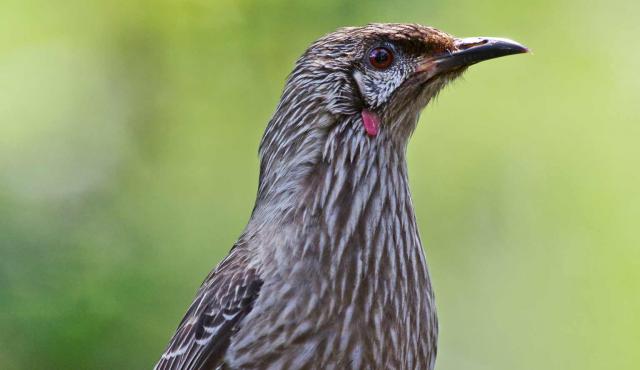A range of teacher professional learning programs will be developed to accompany the Biodiversity of the Western Volcanic Plains online outreach...




Red Wattlebird
Anthochaera carunculata
Breeds most months but more commonly from July to December. Clutch size is 2-3 eggs which are incubated mainly by the female for 15-16 days.This species can raise two broods in one season. Both sexes feed the young.
| Details | Description |
| Type | Bird |
| Group | Honeyeater |
| Identifying Characteristics | |
| Distinctive Markings | Fleshy, reddish wattle on side of neck. Long tail with a white tip. |
| Diet | Herbivore. Feeds mainly on nectar. Diet is supplemented with insects, berries and honeydew produced by some insects. |
| Habitat | Eucalypt forests and woodlands, mallee and urban gardens. |
| Native Status | Native to Australia |
| Sounds | Harsh, grating "hrarrark - hrak","'hrrak - a - yak", "hraak - kraka - yak". Female often a more mellow "kieuw - kieuw - kieuw" combined with the calls of the male. |
| Taxonomy | |
| Phylum | Chordata |
| Class | Aves |
| Order | Psittaciformes |
| Family | Meliphagidae |
| Genus | Anthochaera |
| Species | carunculata |

Distribution maps indicate current and historic locations where species have been sighted.
Source: Atlas of Living Australia
| Conservation Status | |
| DEPI Advisory List | Not listed |
| FFG Act | Not listed |
| EPBC Act | Not listed |
The conservation status of species is listed within Victoria and Australia.
The Department of Environment and Primary Industry (DEPI) Advisory List consists of non-statutory advisory lists of rare or threatened flora and fauna within Victoria.
The Flora and Fauna Guarantee Act 1988 (FFG Act) lists threatened species in Victoria. Under the Act, an Action Statement is produced for each listed species.
The Environment Protection and Biodiversity Conservation Act 1999 (EPBC Act) is the Australian Government’s key piece of environmental legislation, listing nationally threatened native species and ecological communities.



